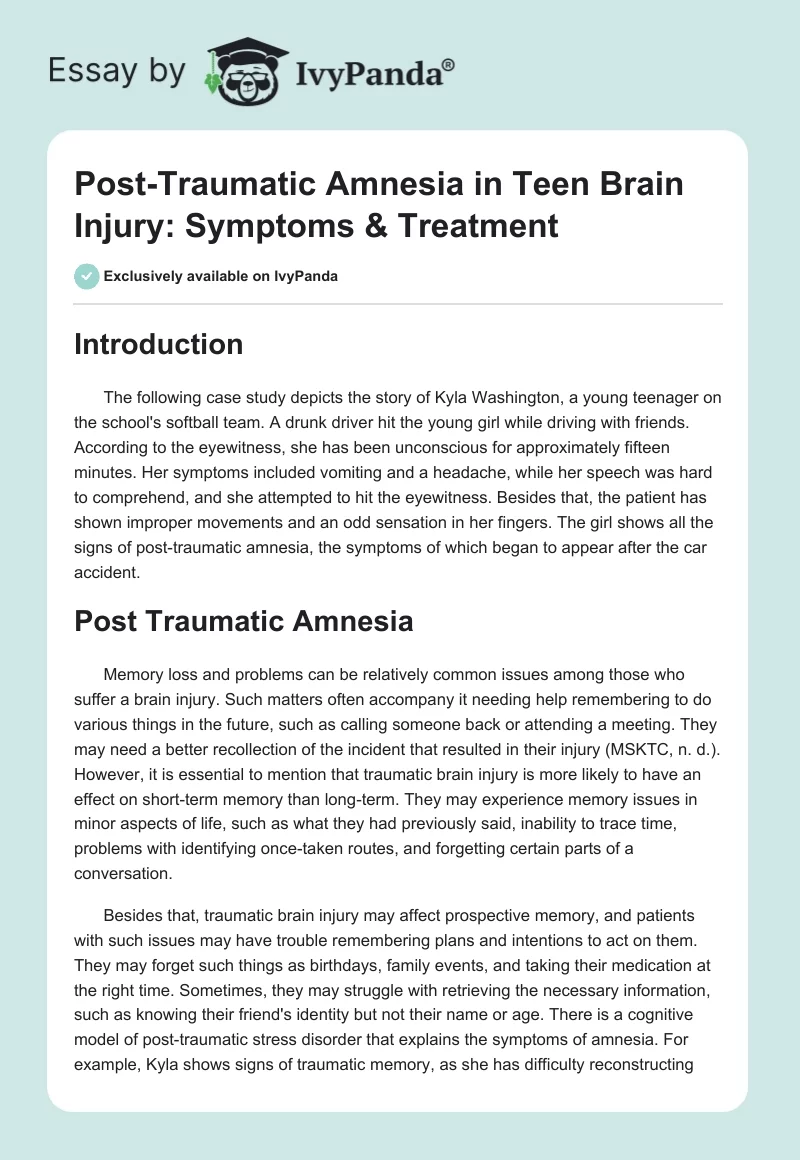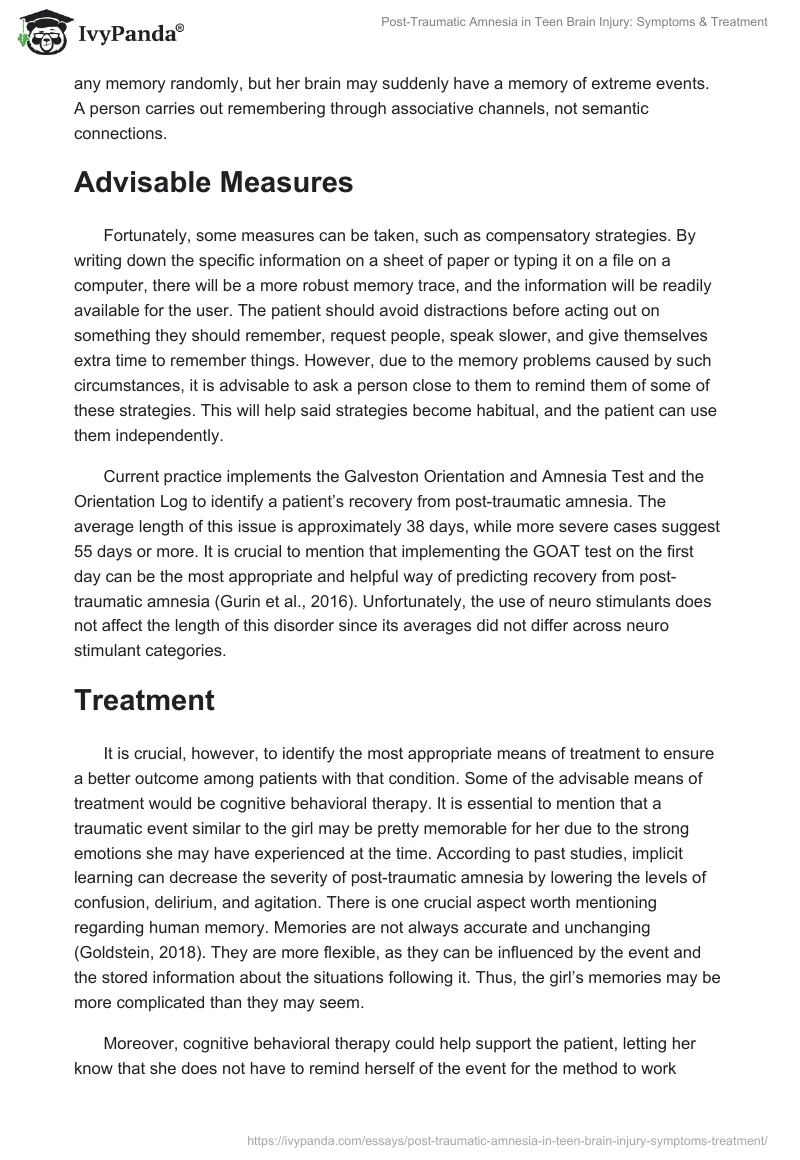Introduction
The following case study depicts the story of Kyla Washington, a young teenager on the school’s softball team. A drunk driver hit the young girl while driving with friends. According to the eyewitness, she has been unconscious for approximately fifteen minutes. Her symptoms included vomiting and a headache, while her speech was hard to comprehend, and she attempted to hit the eyewitness. Besides that, the patient has shown improper movements and an odd sensation in her fingers. The girl shows all the signs of post-traumatic amnesia, the symptoms of which began to appear after the car accident.
Post Traumatic Amnesia
Memory loss and problems can be relatively common issues among those who suffer a brain injury. Such matters often accompany it needing help remembering to do various things in the future, such as calling someone back or attending a meeting. They may need a better recollection of the incident that resulted in their injury (MSKTC, n. d.). However, it is essential to mention that traumatic brain injury is more likely to have an effect on short-term memory than long-term. They may experience memory issues in minor aspects of life, such as what they had previously said, inability to trace time, problems with identifying once-taken routes, and forgetting certain parts of a conversation.
Besides that, traumatic brain injury may affect prospective memory, and patients with such issues may have trouble remembering plans and intentions to act on them. They may forget such things as birthdays, family events, and taking their medication at the right time. Sometimes, they may struggle with retrieving the necessary information, such as knowing their friend’s identity but not their name or age. There is a cognitive model of post-traumatic stress disorder that explains the symptoms of amnesia. For example, Kyla shows signs of traumatic memory, as she has difficulty reconstructing any memory randomly, but her brain may suddenly have a memory of extreme events. A person carries out remembering through associative channels, not semantic connections.
Advisable Measures
Fortunately, some measures can be taken, such as compensatory strategies. By writing down the specific information on a sheet of paper or typing it on a file on a computer, there will be a more robust memory trace, and the information will be readily available for the user. The patient should avoid distractions before acting out on something they should remember, request people, speak slower, and give themselves extra time to remember things. However, due to the memory problems caused by such circumstances, it is advisable to ask a person close to them to remind them of some of these strategies. This will help said strategies become habitual, and the patient can use them independently.
Current practice implements the Galveston Orientation and Amnesia Test and the Orientation Log to identify a patient’s recovery from post-traumatic amnesia. The average length of this issue is approximately 38 days, while more severe cases suggest 55 days or more. It is crucial to mention that implementing the GOAT test on the first day can be the most appropriate and helpful way of predicting recovery from post-traumatic amnesia (Gurin et al., 2016). Unfortunately, the use of neuro stimulants does not affect the length of this disorder since its averages did not differ across neuro stimulant categories.
Treatment
It is crucial, however, to identify the most appropriate means of treatment to ensure a better outcome among patients with that condition. Some of the advisable means of treatment would be cognitive behavioral therapy. It is essential to mention that a traumatic event similar to the girl may be pretty memorable for her due to the strong emotions she may have experienced at the time. According to past studies, implicit learning can decrease the severity of post-traumatic amnesia by lowering the levels of confusion, delirium, and agitation. There is one crucial aspect worth mentioning regarding human memory. Memories are not always accurate and unchanging (Goldstein, 2018). They are more flexible, as they can be influenced by the event and the stored information about the situations following it. Thus, the girl’s memories may be more complicated than they may seem.
Moreover, cognitive behavioral therapy could help support the patient, letting her know that she does not have to remind herself of the event for the method to work appropriately. They may help her describe her experience, identify the cognitive problem and coach her on creating adaptive conditions to perform outside her therapy sessions (Wilson et al., 2018). Since post-traumatic amnesia is known to be the most appropriate way of predicting cognitive outcomes after a brain injury, extra measure, such as using the WPTAS scale, can be implemented to define her outcomes (Briggs et al., 2022; Tenovuo et al., 2021). When combined with the PTA duration data and the GCS, it will be easier to monitor her condition.
Conclusion
In conclusion, Kyla Washington suffered a severe brain injury, which could lead to memory loss or post-traumatic amnesia. The management of this condition could be used to monitor her state and cognitive abilities. Some advisable means to assist the young patient with memory problems would be using scales, such as the WPTAS, implementing cognitive behavioral therapy, and monitoring her condition. Cognitive behavioral therapy could support her, stating that she does not have to remember the traumatic event. Implicit learning could help improve her mental abilities and decrease her delirium, agitation, and confusion symptoms. Besides that, she could be taught how to use the acquired adaptive conditions outside her therapy sessions with her friends and relatives.
References
Briggs, R., Epps, A., Brookes, N., Tate, R., & Lah, S. (2022). Predictive validity of the Westmead post‐traumatic amnesia scale for functional outcomes in school‐aged children who sustained a traumatic brain injury. Journal of Neuropsychology. Web.
Goldstein, E. B. (2018). Cognitive psychology: Connecting mind, research, and everyday experience. Cengage Learning.
Gurin, L., Rabinowitz, L., & Blum, S. (2016). Predictors of recovery from posttraumatic amnesia. The Journal of Neuropsychiatry and Clinical Neurosciences, 28(1), 32-37. Web.
MSKTC. (n.d.). Memory and traumatic brain injury. Web.
Tenovuo, O., Diaz-Arrastia, R., Goldstein, L. E., Sharp, D. J., Van der Naalt, J., & Zasler, N. D. (2021). Assessing the severity of traumatic brain injury—Time for a change?Journal of Clinical Medicine, 10(1), 148. Web.
Wilson, J. L., Hunter, W. M., O’Rourke, J. J., & Soble, J. R. (2018). Restructuring blank spaces: The role of cognitive-behavioral interventions for two patients with post-traumatic amnesia after severe traumatic brain injury. Military Medicine, 184(1-2), e266-e271. Web.


